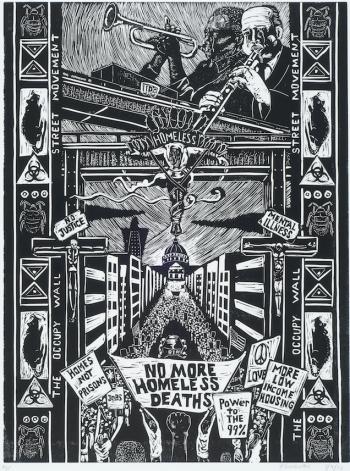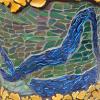Compelling, Historic Work By El Taller de Gráfica Popular on Display at GMOA
Art Notes

Adolfo Mexiac
VIVA TALLER: Following the Mexican Revolution, during a time marked by relative peace, yet still burdened by social and political discord, printmaking collective El Taller de Gráfica Popular (the Workshop for Popular Graphics) understood art’s ability to transcend barriers of language and educate society on complex global issues. “El Taller de Gráfica Popular: Vida y Arte,” currently on display at the Georgia Museum of Art, is a tremendous exhibition of roughly 250 works demonstrating the collective’s prolific contributions to the Mexican printmaking tradition. Both artistically compelling and rich in narrative content, the artists’ small flyers (volantes), large posters (cartels), fine art portfolios and calavera newspapers are loaded with brazen symbols of revolution, calls for unity and opposition to Nazi and fascist ideologies.
TGP was founded in 1937 by artists Leopoldo Méndez, Pablo O’Higgins and Luis Arenal as a communal workshop for creating graphic art for its predecessor organization, Liga de Escritores y Artistas Revolucionarios (LEAR). Deeply committed to empowering the proletariat, the collective regularly supported communism and produced commissions for various labor and farmer unions in the form of posters, handbills, banners and other illustrations. Every Friday, members gathered for stimulating discussions through which each artist’s work was respectfully critiqued and new assignments were distributed. TGP has included over 100 members since its inception, with just as many guest artists traveling from abroad to attend workshops.
The TGP’s interest in global affairs was far-reaching, evocatively demonstrated through illustrations for El libro negro del terror nazi en Europa, a horrific book—compiled by German exiles who were living in Mexico during WWII—that documents Nazi atrocities through invaluable firsthand accounts, photographs, drawings and prints. The intensity of the exhibition’s brutal anti-Nazi pieces is balanced by a collection of calavera newspapers—a faithful homage to José Guadalupe Posada and the traditional Día de los Muertos style—that humorously satirize Mexican politics through skeletal caricatures.
The exhibition’s accompanying catalogue, published by GMOA under the same title, is one of the first authoritative texts written in English on the TGP. Beautifully executed, the book supplements the show through additional images and essays offering in-depth analysis of the TGP’s history and role in both informing and inspiring its audience through sociopolitical art.
The museum will host several events in association with “Vida y Arte,” most notably a panel discussion with El Taller members Arturo García and Rina Lazo, Pablo Méndez (son of artist Leopoldo Méndez) and scholars on Thursday, Aug. 20 at 7 p.m.
A special ¡Viva México! Film Series will screen An Artful Revolution: The Life and Art of the Taller de Gráfica Popular on Thursday, July 9 at 7 p.m. and The Storm That Swept Mexico on Thursday, July 16 at 7 p.m.
Children can experiment with various printmaking techniques in a workshop during Family Day on Saturday, June 20 from 10 a.m.–1 p.m. and a Teen Studio on Thursday, Aug. 27 from 5:30–8:30 p.m. Curator of American art Sarah Kate Gillespie will lead a Tour at Two on Wednesday, June 24 and Wednesday, Sept. 9 at 2 p.m., and curator of education Carissa DiCindio will lead an in-depth Artful Conversation on Wednesday, July 8 at 2 p.m.

"No More Homeless Deaths" by Ronnie Goodman
FIGHTING THE GOOD FIGHT: Complementing the socially conscious printmaking found in “Vida y Arte,” GMOA has opened a second new exhibition, “Art Hazelwood and Ronnie Goodman: Speaking to the Issues.” Curated by museum director William U. Eiland, the show centers on two California Bay Area contemporary artists who deliver fierce punches of sociopolitical commentary through striking black-and-white linocuts, woodcuts, etchings and mixed media. Continuing the tradition of cultural activism through visual art, the works of Hazelwood and Goodman boldly confront modern-day issues of homelessness, poverty, violence and injustice.
The two artists met through the San Quentin Art in Correction Program, which was taught by Hazelwood and attended by Goodman while he was serving time for a burglary conviction. Goodman has spent much of his life living on the streets—a vantage point from which he truly experiences the harsh reality of his subject matter first-hand—but he has continued creating artwork by obtaining materials through the San Francisco resource center, Hospitality House. Hazelwood’s own artwork has become progressively more politicized over time through his contributions to Street Sheet, a publication put out by the Coalition on Homelessness, and to the Western Regional Advocacy Project, which also focuses on advocating for underserved communities.
Eiland will lead a Tour at Two for “Speaking to the Issues” on Wednesday, Aug. 19 at 2 p.m. Both “Vida y Arte” and “Speaking to the Issues” will remain on view through Sunday, Sept. 13. The exhibitions will serve as inspiration for the Friends of GMOA’s quarterly reception, 90 Carlton: Summer, on Friday, July 17 from 5:30–8:30 p.m., as well as Museum Mix, the thrice-annual late-night art party with a DJ, on Thursday, Aug. 6 from 8 p.m.–12 a.m. Student Night is set for Thursday, Sept. 10 from 6:30–8:30 p.m.
More by Jessica Smith
-

Art Around Town
A list of local art exhibits.
-

-

Art Around Town
A list of local art exhibits.









comments